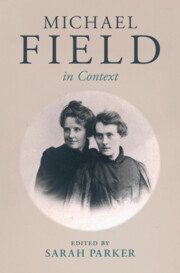Refine search
Actions for selected content:
578 results
Chapter 20 - Print and the Question of Literature in Islamic West Africa
- from Part IV - Worlds of Print
-
-
- Book:
- African Literature in Transition
- Published online:
- 23 October 2025
- Print publication:
- 06 November 2025, pp 392-408
-
- Chapter
- Export citation
“The Only Language Common to All”: Poesia Negra and Black Grammars of Solidarity
-
- Journal:
- African Studies Review / Volume 68 / Issue 3 / September 2025
- Published online by Cambridge University Press:
- 31 October 2025, pp. 513-532
-
- Article
-
- You have access
- Open access
- HTML
- Export citation
Chapter 2 - An Atlas of Energy Poetics
-
- Book:
- American Modernism and the Cartographic Imagination
- Published online:
- 09 October 2025
- Print publication:
- 23 October 2025, pp 68-110
-
- Chapter
- Export citation
Chapter 7 - Poetry in, or around, Bloomsbury
- from Part I - Aesthetic Bloomsbury
-
-
- Book:
- A History of the Bloomsbury Group
- Published online:
- 09 October 2025
- Print publication:
- 23 October 2025, pp 102-118
-
- Chapter
- Export citation
Chapter 6 - Expressing the Unnamable
- from Part I - Linguistic Implications of Kant’s Thought
-
-
- Book:
- Kant on Language
- Published online:
- 19 September 2025
- Print publication:
- 09 October 2025, pp 102-119
-
- Chapter
- Export citation

Michael Field in Context
-
- Published online:
- 03 October 2025
- Print publication:
- 25 September 2025
Preface
-
- Book:
- Michael Field in Context
- Published online:
- 03 October 2025
- Print publication:
- 25 September 2025, pp xv-xxi
-
- Chapter
- Export citation
Chapter 6 - Metasecurity Dilemmas in John Milton’s Late Poems
-
- Book:
- Security, Fiscal Policy, and Sovereignty in Renaissance English Literature
- Published online:
- 04 September 2025
- Print publication:
- 18 September 2025, pp 161-202
-
- Chapter
- Export citation
Uninvited Guests and Biting Dogs: Munīr Lāhorī and the Definition of an Indo-Persian Literary Tradition
-
- Journal:
- Iranian Studies ,
- Published online by Cambridge University Press:
- 27 August 2025, pp. 1-16
-
- Article
-
- You have access
- Open access
- HTML
- Export citation
6 - The Literary Singularity of Roots Manuva’s Awfully Deep
- from Part II - Approaches to Rap
-
-
- Book:
- The Cambridge Companion to Global Rap
- Published online:
- 25 July 2025
- Print publication:
- 14 August 2025, pp 100-112
-
- Chapter
- Export citation
Translations Interrupted: Italian Neorural Revivals and the Neodialect Poetics of Nonscalability
-
- Journal:
- Signs and Society / Volume 13 / Issue 3 / September 2025
- Published online by Cambridge University Press:
- 04 August 2025, pp. 326-354
-
- Article
-
- You have access
- Open access
- HTML
- Export citation
Chapter 4 - The Mid Nineteenth-Century Press and Periodical Poetry
- from Part I - Transacting
-
-
- Book:
- Latinx Literature in Transition, 1444–1886
- Published online:
- 06 August 2025
- Print publication:
- 17 July 2025, pp 106-124
-
- Chapter
- Export citation
Chapter 16 - Capitalism and Racial Form in Three Contemporary US Poets
- from Part II - Histories
-
-
- Book:
- Money and American Literature
- Published online:
- 03 July 2025
- Print publication:
- 17 July 2025, pp 274-292
-
- Chapter
- Export citation
Chapter 34 - Poetry, Short Stories, Journalism, and Non-Fiction
- from Part V - Non-Theatrical Writings
-
-
- Book:
- Sean O'Casey in Context
- Published online:
- 23 June 2025
- Print publication:
- 10 July 2025, pp 372-380
-
- Chapter
- Export citation
Chapter 5 - CantoMundo, Undocupoets, Letras Latinas, and the Cultivation of Latinx Poetry
- from Part I - Shifting Coordinates
-
-
- Book:
- Latinx Literature in Transition, 1992–2020
- Published online:
- 19 June 2025
- Print publication:
- 03 July 2025, pp 96-112
-
- Chapter
- Export citation
Trying Haiku Poetry: Collective Creativity in a Haiku Gathering
- Part of
-
- Journal:
- Asia-Pacific Journal / Volume 23 / 2025
- Published online by Cambridge University Press:
- 24 June 2025, e10
-
- Article
-
- You have access
- Open access
- HTML
- Export citation
4 - Back from the Edge
-
- Book:
- Waves of Hope
- Published online:
- 26 May 2025
- Print publication:
- 12 June 2025, pp 63-90
-
- Chapter
- Export citation
21 - Holocaust Literature
- from Part IV - Culture and Fields
-
-
- Book:
- The Cambridge History of the Holocaust
- Published online:
- 16 May 2025
- Print publication:
- 12 June 2025, pp 490-509
-
- Chapter
- Export citation
21 - Commodian, Instructions
- from Part IV - Policing the Community
-
-
- Book:
- The Cambridge Edition of Early Christian Writings
- Published online:
- 19 May 2025
- Print publication:
- 12 June 2025, pp 393-451
-
- Chapter
- Export citation
14 - The Holocaust and the Challenges of Representation
- from Part III - Culture and Ideas
-
-
- Book:
- The Cambridge History of the Holocaust
- Published online:
- 16 May 2025
- Print publication:
- 12 June 2025, pp 332-352
-
- Chapter
- Export citation
